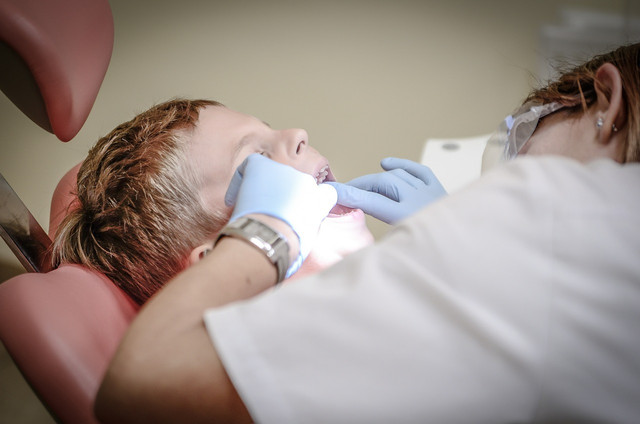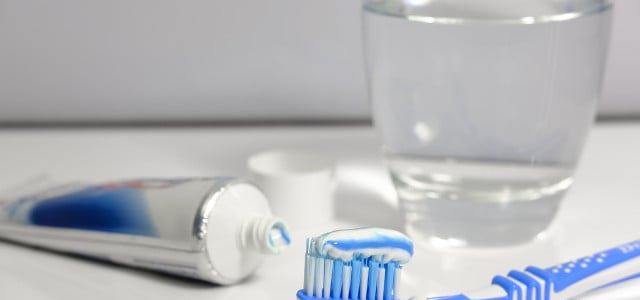Is fluoride for teeth healthy or harmful? Where does it come from, and where can one find it? Today, we will take a closer look at this controversial compound and answer all of these questions, and more.
What is Fluoride?
Fluoride is a mineral that can be found in natural elements like water and soil, as well as in some types of food products. We generally ingest it with our diet or with water – since in some areas, water is fluoridated artificially to increase our intake. That’s because dental cavities can be prevented and tooth enamel strengthened when fluoride is ingested.
Dental decay can be reduced by adding fluoride to water in areas where fluoride levels in the water are low – that has been proven by several studies which are referenced in this study from 2018. The examination also sums up findings which indicate that fluoride can slow and even reverse the progression of existing lesions.
Is Fluoride Good for Teeth?

(Foto: CC0 / Pixabay / LionFive)
Why do teeth decay? Bacteria in dental plaque produce acids, which can destroy tooth tissue. Bacteria and germs that survive and thrive in already-weakened tooth enamel can go on to create cavities. If you consume sugary foods regularly, you’ll experience “acid attacks” more frequently. Fluoride can be used to counteract the acid-related deterioration of tooth enamel.
As the 2018 study we shared earlier suggests, fluoride for teeth may be a valuable tool to maintaining good oral health, as it:
- Inhibits the growth of harmful oral microbes
- Reduces de-mineralization in sound enamel
- Prevents cavities
- Promotes dental enamel remineralization
- Reverses early signs of tooth decay.
Where Does Fluoride Come from?
Fluoride ions enter the mouth in a multitude of ways:
- Topical products: toothpaste, mouthwashes, and varnish can be used to deliver fluoride directly to the teeth.
- Ingestion: This occurs primarily through fluoridated water and food products. But fluoride is also a naturally occurring element found in food and water across the world. Certain products like black and green tea and saltwater fish are common non-dental fluoride sources.
This means fluoride is often consumed daily without even realizing it. Southern Asia, the eastern Mediterranean, and Africa in particular have naturally high fluoride water. However, levels can vary: for example, rural areas often do not have access to fluoridated water, because the practice is not feasible or cost-effective.
When fluoride for teeth is ingested, a minuscule amount is continuously secreted into the mouth as saliva. As much as half of the fluoride ingested is absorbed and kept in bones and teeth, while most is eliminated in urine.
If you live in an area where the water is not fluoridated, fluoride supplements may be recommended by dentists, but we do not recommend taking these. Understandably, the FDA is wary of fluoride supplements, given how easy it is to take too much of them.
In What Ways and to Whom Is Fluoride Beneficial?
To reiterate, it is possible to alleviate dental discomfort by having your teeth fluoridated, which remineralizes the enamel. Fluoride is widely recommended by some public health organizations, such as the American Dentist Association and The U.S. National Academy of Sciences Institute of Medicine, as a valuable means to prevent tooth decay in children and adults.
A variety of individuals undergoing different dental treatments may benefit from fluoride for teeth, including people with:
- Sensitive teeth and gums
- Receding gums
- Whitening treatments
- Cavities
- Tooth decay through excessive sugar and carb consumption
Are There Any Dangers of Fluoride for Teeth?



(Foto: CC0 / Pixabay / jarmoluk)
In spite of the fact that fluoride is an all-natural chemical, it has somewhat of a controversial reputation, and their is still ongoing debate over whether the benefits outweigh the risks.
According to some critics and research institutes, fluoridated water can potentially create health issues. However, the credible evidence for such claims seems to be conflicting and there’s a lack of credible, concrete long-term research findings on the topic.
- For example, a 2006 study connected childhood fluoridated water exposure to increased male bone cancer rates. Whereas a 2011 research paper and a 2016 analysis found no link between the two.
- The results of studies on fluoride correlating to low IQ in children are likewise divided. A connection between neurological development in children and fluoride has been suggested in the past, but again, more large-scale studies are needed.
Nevertheless, there are some dental conditions firmly associated with excessive fluoride exposure. For example:
- Skeletal fluorosis can calcify ligaments and change bone structure. Sore joints and stiffness are early signs. This disease is caused by chronic high-level exposure to fluoride. According to the WHO, this acute high-level exposure is rare and usually due to accidental contamination of drinking-water or due to fires or explosions.
- Dental fluorosis is caused by ingesting too much fluoride during tooth development. It causes tooth stains, like white spots on the teeth. Dental fluorosis otherwise causes little harm. According to the American Dental Association, it usually affects children until about age eight and can be prevented by getting the right amount of fluoride. You can determine it with the help of your dentist, pediatrician or family physician. The American Academy of Pediatric Dentistry (AAPD) advises parents and caregivers to use a small quantity of fluoride toothpaste on infants.
If you worry about your fluoride intake, consider seeing your dentist or doctor for a medical opinion. If you find that you have reason to lower your intake, have a close look at products you consume, for example bottled water and toothpaste. If they include fluoride, have a look for alternative brands without fluoride.
Does My Water Have Enough Fluoride?



(Foto: CC0 / Pixabay / kaboompics)
Not all American cities fluoridate their water. Each city decides whether or not to fluoridate. More than 70 percent of the U.S. population now receives fluoridated water, which was first introduced in the country in the 1940s.
Check if your city fluoridates its water source. If it does, you’ll know how much they add. You can also consult the EPA website for further information.
The World Health Organization recommends a maximum level of 1.5 milligrams per liter of fluoride in drinking water. Fluoride levels in drinking water in the United States have been capped at 0.7 parts per million (ppm) as of 2015.
Read on:
- Teeth Whitening Home Remedies: What You Should Know
- DIY Mouthwash: Oral Hygiene with Natural Ingredients
- Zero Waste Toothpaste: The Growing Trend Towards No-Waste Pastes
Important Information regarding Health-related Topics.
** Links to retailers marked with ** or underlined orange are partially partner links: If you buy here, you actively support Utopia.org, because we will receive a small part of the sales proceeds. More info.Do you like this post?






